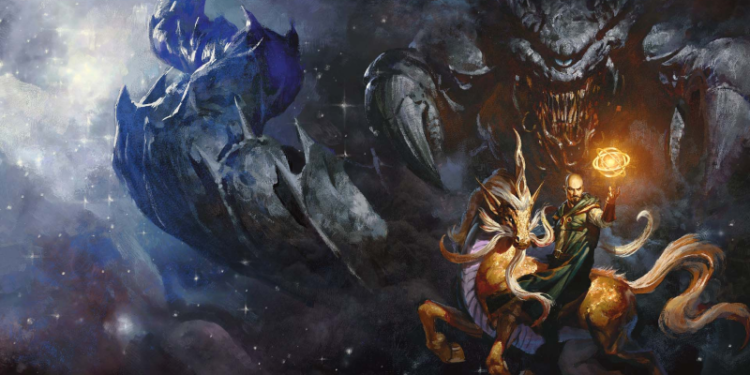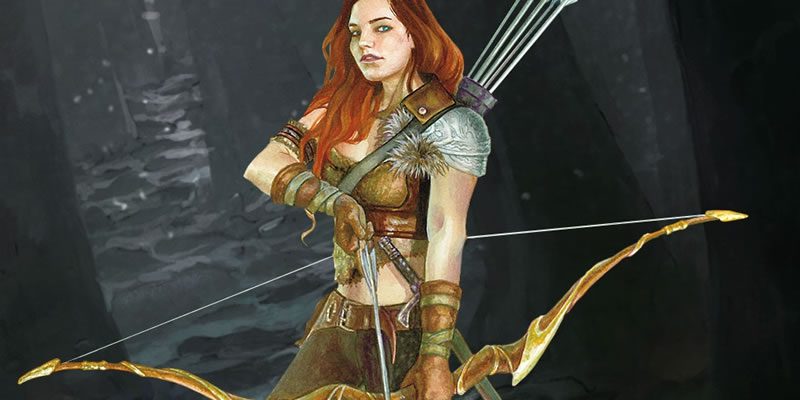
In the first article in this series, I covered about a third of the races in MotM. Today I’m hoping to repeat that trick, because it’s a lot of races. As a reminder, I’m doing as much line-by-line comparison to their earlier versions as I can, but I’m going to miss stuff. It’s okay to let me know.
Part One: Aarakocra – Genasi | Part Two
Githyanki
The gith are a specific case of a race that might not need setting-agnostic lore, because they come from the interstitial space between settings. Also I desperately wish for a 20-level campaign with Lich Queen Vlaakith CLVII as the main villain and many shenanigans in Tu’narath. WotC, you know how to get in touch.
- Humanoid, Medium, 30-ft walking speed. I’m vaguely surprised that Small isn’t an option for gith?
- Astral Knowledge gives you a wildcard skill proficiency and weapon or tool proficiency, decided once per long rest. This was previously Decadent Mastery (one extra language, skill, and tool proficiency, because in Tu’narath you have all the time that isn’t in the world) and Martial Prodigy (proficiency in short/long/great swords). You have less actual stuff at any one time, but that wildcard can make a huge difference.
- Githyanki Psionics gives you the invisible mage hand cantrip (their handling for low-power telekinetic force), as well as jump 1/long rest at 3rd level and misty step 1/long rest at 5th The only change from Mordenkainen’s Tome of Foes is that you can choose Int, Wis, or Cha as your spellcasting stat now… not that you mostly care about your spellcasting stat for any of these spells. Oh, and you can spend spell slots to keep using those spells.
- Psychic Resilience grants resistance to psychic damage. This is fully new in MotM.
This githyanki is a clear power boost compared to its predecessor. I would absolutely play this and have a good time telling stories about Tu’narath during rests.
Githzerai
I love githzerai too, though it took until some of the late-4e flavor text for me to find stuff that I latched onto as much as Dakkon in Planescape: Torment.
- Humanoid, Medium, 30-ft walking speed.
- Githzerai Psionics is, again, invisible mage hand, plus shield 1/long rest at 3rd level and detect thoughts 1/long rest at 5th. Same effects at the same levels, but now you can choose your casting stat (which matters quite a lot for detect thoughts) and you can use spell slots to keep casting these spells (which is huge for shield, maybe in the hands of a githzerai paladin or ranger…)
- New plan: Githzerai Monster Slayer ranger.
- Mental Discipline grants advantage on saves to avoid or end the charmed and frightened conditions. No change except for the against -> avoid or end language, and trimming out the flavor text discussing the tutelage of monastic masters.
- Psychic Resilience, as above for the githyanki. I do want to point out that Mental Discipline + Psychic Resilience add up to sturdy defenses against mind flayers, if nowhere near immunity.
In knowing the teachings of Zerthimon, [they] have become stronger.
Goblin
Okay, there’s a whole thing around goblinkind and the fey/humanoid split, which I touched on with bugbears last time and I’ll be covering in a lot more detail once we get to the NPC stat blocks a bit later in this series. The salient point is that PC goblinkind are humanoids.
- Humanoid, goblinoid, Small, 30-ft walking speed.
- Darkvision, 60 ft.
- Fey Ancestry grants advantage on saves to avoid or end the charmed condition. This trait is completely new for goblins.
- Fury of the Small now adds your proficiency bonus to damage, PB times per long rest; this is a change from +level to damage, 1/short or long rest. See previous “I’m not getting into the demise of short rests.”
- Nimble Escape lets you Disengage or Hide as a bonus action.
Fey Ancestry is a nice upgrade; it’s otherwise fairly power-neutral. I love goblins but my ideas of what they should be like, as a PC race, are completely different. I don’t object to what’s in this book, though.
Goliath
Giants are cool, let’s let people play quasi-giants! (The link shows that I am in explicit and professional support of this.)
- Humanoid, Medium I’m not at all surprised Small isn’t an option), 30-ft walking speed.
- Little Giant (no I just said not having a Small one was okay!) is a rename of Natural Athlete (proficiency in Athletics) as well as Powerful Build.
- Mountain Born grants cold resistance and acclimation to high altitudes. The only change here is that the text specifies “even if you’ve never been to [high altitudes].”
- Stone’s Endurance reduces the damage from one source by 1d12 + Con. It was previously 1/short or long rest, and is now PB uses/long rest. This one especially tests my commitment not to write a five-page digression on short rests.
- I wonder what made them decide to change the language from “you can focus yourself to shrug off injury” to “you can supernaturally draw on unyielding stone to shrug off harm.” Too close to a trained rather than innate ability?
Very near to unchanged. All good here.
Harengon
As with fairies in the previous article, these are recent enough releases that there are no changes to the rules text. Whew, that was quick. (Yes, okay, I still haven’t covered WBW in a breakdown article. I don’t know what to tell you, it landed at a time I was utterly swamped with freelancing. That and Van Richten are next up on my docket once I finish this book.)
Hobgoblin
I just want to say that the hobgoblin bard in the artwork here has a deeply impractical and unsafe musical instrument. I’m not sure even his splint armor is going to save him here.
- Humanoid, goblinoid, Medium, 30-ft walking speed.
- Darkvision, 60 ft.
- Fey Ancestry does what Fey Ancestry does.
- Fey Gift improves the Help action for you, both making it a bonus action PB times/long rest, and giving you three different extra effect options:
- Hospitality grants you and the creature you’re helping 1d6+PB temporary hit points.
- Passage grants +10 ft walking speed to you and your target for a round.
- Spite grants your target’s attack the additional property of imposing disadvantage on their target’s next attack roll.
- Fortune from the Many retools Saving Face to be something more conceptually positive rather than shaming. Once your d20 roll is a failure, you can gain a bonus to that roll equal to the number of nearby allies you can see, now capped at +3 rather than +5. It is also changed from 1/short or long rest to PB/long rest.
Martial Training is completely gone, which is fine because it was useless for most classes.
Kenku
That’s so raven!
- Humanoid, Medium (we miss you, Carol Spinney) or Small, 30-ft walking speed.
- Expert Duplication gives you advantage on ability checks to commit forgery with writing or craftwork. The name of the trait has changed from “Forgery” to “Duplication” to be a little less, you know, judgy.
- I think we’re overlooking the production-line capabilities of an unkindness of kenku.
- Kenku Recall grants proficiency in two skills of your choice, replacing Kenku Training; and lets you gain advantage on a proficient skill check, PB times per long rest.
- I’ve mentioned this before but here we go again. The second part of this trait should have been rerolls rather than advantage, because a fair amount of the time when you have advantage on a roll, it was a wasted use, because your first roll succeeded.
- Rerolls also have meaningful problems in skill checks, though, especially if you’re rolling Stealth against an as-yet-indeterminate Perception score (because you haven’t yet moved into a particular creature’s sensory range).
- Mimicry lets you repeat sounds, including voices. It has changed from an opposed Insight vs Deception check to an Insight check against 8 + your PB + your Cha modifier. This means that you don’t need to spend one of your Kenku Recall skills on Deception, and takes Expertise out of the picture.
Edited: The outstanding change here is that the kenku limitation to only mimic things they’ve heard, to never speak with their own voice, is completely gone. It made them hard to play, but the challenge added a lot of interest during play for the dedicated player.
Kobold
I’m not as attached to kobolds as I am to goblins, but I’m interested in seeing a completely new version of their racial features, as we get here. This is a good place for a reminder that 5e doesn’t support the idea that a PC and NPC of the same race need to get the same features from it.
- Humanoid, Small (a Medium kobold is called a dragonborn, right?), 30-ft walking speed.
- Darkvision, 60 ft.
- Draconic Cry lets you shout as a bonus action, PB uses/long rest. You and your allies have advantage on attacks against enemies within 10 feet of you. This is a massive reskin of Grovel, Cower, and Beg, which sort of explains why this “shout” is more of a 10-ft-radius “chirp.”
- Kobold Legacy gives you a choice of one of three different traits.
- Craftiness gives you one skill, chosen from Arcana, Investigation, Medicine, Sleight of Hand, or Survival. Obviously good for all characters, and best for Int-, Wis-, or Dex-focused characters.
- Defiance grants advantage on saves to avoid or end frightened. Good for everyone that doesn’t get this or frightened immunity.
- Draconic Sorcery gives you one sorcerer cantrip, with your choice of Int, Wis, or Cha as your spellcasting stat. I expect the usefulness of this trait to vary wildly between characters, but bards, clerics, paladins, and rangers are likely to appreciate fire bolt or green-flame blade.
Notably gone are Pack Tactics and Sunlight Sensitivity. The nu!kobold looks pretty fun to play, to me.
Lizardfolk
There are a lot of ways to be a little bit reptilian these days, huh?
- Humanoid, Medium, 30-ft walking speed and a swimming speed equal to your walking speed.
- Bite gives you a 1d6 + Str slashing damage unarmed strike. Kinda wondering how they decided that this bite needed to be slashing rather than piercing, as it was in VGTM.
- Hold Breath gives you a 15-minute dive time, without going to the full Amphibious trait, for what should be fairly obvious reasons. (To wit, lizards aren’t amphibians.)
- Hungry Jaws gives you a special bonus action Bite attack, PB uses per long rest, that also gives you temporary hit points equal to your PB (not your Con modifier anymore) if the attack hits.
- Natural Armor gives you an AC of 13 + your Dex modifier, though you also have the option to wear other armor instead. No change from the previous version.
- Nature’s Intuition gives you two skill proficiencies, chosen from a very ranger- or druid-friendly list. This replaces Hunter’s Lore and adds Medicine as an option.
Very little change, overall. Be real, you weren’t picking Medicine with Nature’s Intuition anyway. You might not take it even if you already had proficiency in every other skill on that list.
Minotaur
The suggestion in this brief lore section that the Lady of Pain created minotaurs to patrol the Maze is pretty awesome. Yes, give me that tiny hope for Planescape content—it’s a lot better than “they pretty much belong to Baphomet, sorry,” and more generally applicable than Ravnica’s lore.
- Humanoid, Medium, 30 ft. (If you’re Small, you’re tasty to monsters, because you might be made of veal.)
- No, not really.
- Horns give you a 1d6 + Str piercing unarmed strike. No change from Guildmaster’s Guide to Ravnica
- Goring Rush lets you Dash as an action and make a Horns attack as a bonus action. No change.
- Hammering Horns lets you push a creature 10 feet as a bonus action immediately after you hit with a melee attack, if it fails a Strength save. No change.
- Labyrinthine Recall means you always know which way is north and you have advantage on Survival checks for navigation or tracking. This replaces Imposing Presence, which granted proficiency in either Intimidation or Persuasion.
Overall, that looks like a side-grade in power to me, as long as you pick up Survival from elsewhere and incorporate tracking or navigation rolls into your needs; otherwise it’s a modest step down.
Orc
I’m a big fan of the Eberron/Exandria orc traits, which I’ve been using for my orc ranger PC in a Tomb of Annihilation campaign – those stats are exactly the upgrade I personally needed over the VGTM orc traits. Let’s see how this stacks up.
- Humanoid, Medium (little surprised Small isn’t an option here), 30-ft walking speed.
- Darkvision, 60 ft.
- Adrenaline Rush lets you Dash as a bonus action, PB uses/long rest. When you do, you also gain PB temporary hit points. This replaces Aggressive, which required the movement to end closer to an enemy. Making this trait useful for both sides of a chase scene is a big help.
- Powerful Build does what Powerful Build does. It’s super useful in a hexcrawl where you have to carry a lot of supplies on your back and pack animals are impractical or unavailable.
- Relentless Endurance gives you the same trait that half-orcs have, saving you from one instance of falling to 0 hit points per long rest. This replaces Primal Intuition, which gave you two skills from a list that every ranger would want.
- This would have saved my character’s bacon a time or two, but having two extra skills has been incredible, so… for what I wanted this is a side-grade. I dunno, covering a lot of skill bases for the party feels good, survivability is good, it’s all fine.
I’m very clear that the new design guidance does away with culturally-taught skills and that was the thematic justification for Primal Intuition. So while this character that I love is “losing” something that I enjoy about him, I see why it’s here. A trait that shows some connection to the half-orc is a welcome marriage of narrative and mechanics. I’m curious to see what half-orcs look like in the 2024 release and whether that connection endures.
Satyr
I like the satyr art here just fine, but I love Satyr Party Grrl in Mythic Odysseys of Theros, so. Also, I’ve gotten to see these stats in extensive use in my Dragon Heist campaign.
- Fey, Medium (aww, no pygmy goat?) 35-ft walking speed.
- Ram gives you unarmed strikes with your head and horns. MOTM bumps your damage up from 1d4 + Str to 1d6 + Str.
- Magic Resistance (Edited, I got it wrong the first time) used to cover “magical effects” as well as spells, and now it’s only spells. Which means you don’t have to resolve the list of things that are magical effects but not spells; it’s simpler, but in the new dynamic, quite a lot less powerful.
- Mirthful Leaps still adds d8 to the number of feet you jump.
- Reveler still grants proficiency in Performance and Persuasion and a musical instrument of your choice.
The change to Magic Resistance is the real impact here.
That’s it for Part Two. The lore changes to the goblin and minotaur are about as momentous as the mechanics changes—that is, some percentage of campaigns wouldn’t even notice. A lot of these non-core races get just a little boost to make them more appealing to play. In the next article, I should be able to finish out Chapter 1: Fantastical Races.



